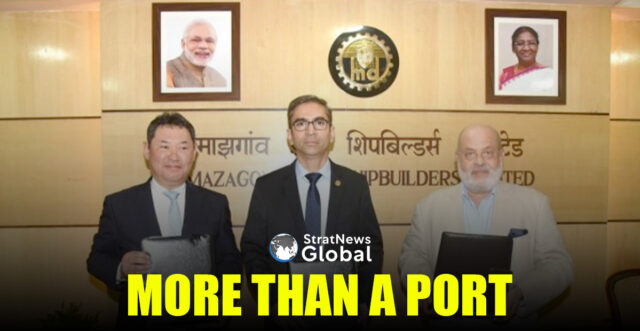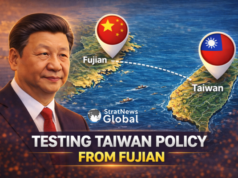India’s acquisition of Sri Lanka’s Colombo Dockyard PLC via its state-run shipbuilder Mazagon Dock Limited (MDL) is far more than a business transaction. Valued at $52.96 million, the move is being billed as a lifeline for Sri Lanka’s ailing shipbuilding sector.
But behind the financial and industrial rationale lies a layered geopolitical power play—one that reflects India’s strategic urgency to counter China’s expanding maritime footprint in the Indian Ocean. Reactions from both sides of the Palk Strait suggest this deal is as politically sensitive as it is commercially significant.
From Delhi’s viewpoint, the MDL acquisition is a textbook case of timely intervention yielding maximum strategic returns.
With Japan’s Onomichi Dockyard exiting its 51% stake and the Colombo Dockyard teetering financially, New Delhi seized a vacuum that could easily have been filled by Beijing. The acquisition cements India’s physical presence at a critical maritime chokepoint—right on the edge of some of the busiest East-West shipping lanes in the world.
This fits squarely within India’s “Security and Growth for All in the Region” (SAGAR) vision and its broader Indo-Pacific strategy. With Chinese-operated ports in Hambantota and increasing PLAN activity in the Indian Ocean, India’s move to control Colombo Dockyard is a signal: Delhi will not concede the backyard.
For MDL, which has long outgrown its Mumbai base, Colombo offers room to scale up operations, shift repair workloads, and tap regional markets. It’s a cost-effective expansion with long-term synergy potential.
In effect, this isn’t just India buying a dockyard—it’s India anchoring itself in the maritime politics of South Asia with sovereign assets.
In Sri Lanka, the narrative is more conflicted. While government-linked channels are painting the deal as a timely rescue for a loss-making shipyard, reactions from civil society and independent media expose deeper anxieties.
For a nation still crawling out of an economic crisis, MDL’s capital infusion is seen as a way to protect jobs, preserve industrial know-how, and keep a vital facility running. Yet, activist groups like Jana Aragala have openly called for a pause, warning that strategic infrastructure must not be handed over without rigorous public debate and scrutiny.
Memories of the 99-year lease of Hambantota Port to China loom large. Critics worry this deal could repeat the pattern of foreign leverage over strategic assets—only this time with India.
The withdrawal of Japan’s Onomichi Dockyard raises questions. Was this just a commercial decision, or a subtle signal of shifting regional bets? Either way, Japan’s retreat contrasts sharply with India’s assertiveness.
This acquisition also marks a significant new phase in South Asian maritime geopolitics.
India is countering China’s so-called “string of pearls” not just with naval deployments or diplomacy, but by owning infrastructure. Colombo Dockyard could become India’s answer to China’s presence in Gwadar and Hambantota.
With this move, India is shifting from being a regional security provider to becoming a long-term economic stakeholder—what some analysts might term “sovereign capitalism for strategic ends.”
Colombo continues to balance competing suitors—China, India, and others—while trying to hold onto its autonomy. The dockyard deal, however, underscores how little room it has when foreign capital becomes a condition for survival.
From Delhi, the MDL-Colombo Dockyard acquisition is a diplomatic and industrial coup—symbolic of a more confident India willing to project power through capital and capacity. From Colombo, it’s a necessary compromise—a trade-off between economic pragmatism and strategic caution.
What happens next will depend on how Sri Lanka manages domestic sensitivities, and whether India uses its new foothold with restraint and respect.
In a career spanning three decades and counting, Ramananda (Ram to his friends) has been the foreign editor of The Telegraph, Outlook Magazine and the New Indian Express. He helped set up rediff.com’s editorial operations in San Jose and New York, helmed sify.com, and was the founder editor of India.com.
His work has featured in national and international publications like the Al Jazeera Centre for Studies, Global Times and Ashahi Shimbun. But his one constant over all these years, he says, has been the attempt to understand rising India’s place in the world.
He can rustle up a mean salad, his oil-less pepper chicken is to die for, and all it takes is some beer and rhythm and blues to rock his soul.
Talk to him about foreign and strategic affairs, media, South Asia, China, and of course India.





